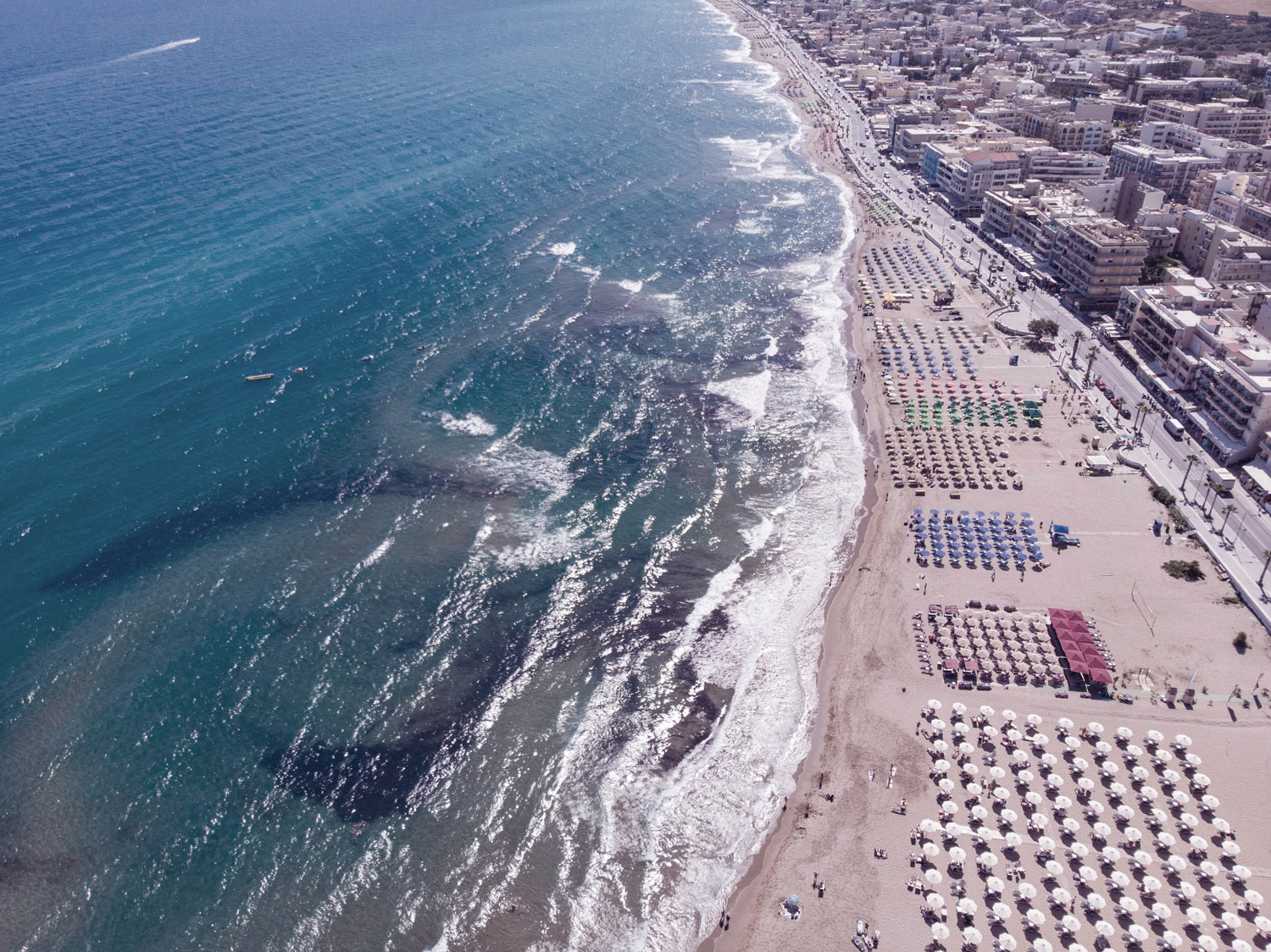STERIS HOTEL
One of the best features of Steris Elegant Beach Hotel as your holiday accommodation is its location, location, location! It is centrally situated on the coastal road of Rethymno city, just minutes away from the city’s buzz.
A mere 20 meter distance, separates you from a golden sand beach, awarded with the Blue Flag, giving you the impression that the beach is the natural extension of our sea view pool area. Along the coast, just across the hotel, there is a beautiful wide pedestrian alley, ideal for walking, strolling, cycling or just sitting and sipping in the morning sun.
The infamous Venetian port of Rethymno is found at just 500 meters away from the hotel. There, one may find plenty of picturesque fish tavernas to choose from and taste delicious traditional greek dishes, or pick a daily cruise to enjoy the coasts and beaches of Rethymno.
Around the hotel, you may find all the amenities you may need. Super Market, pharmacies, ATM, bakery and grocery stores, coffee shops, are found within walking distance.
Given the fact that Rethymno is situated in the middle of the island of Crete, it is an ideal starting point to head outwards and explore the beauties of the entire island. Crete is a mythical place that exudes positive energy and is a destination that excites, inspires and rejuvenates the mind, body and soul.
Rethymno
The city of Rethymno is the third biggest city in Crete, after Heraklion and Chania. It is strategically located between these two larger cities on the north coast of Crete, in an almost equal distance from both.
Its origins are lost in the depths of time, as Rithymna and Arsinoe, the first ancient cities that we know of, were built here around 40 centuries ago, during the heyday of the Minoan Civilization. Another people that largely influenced the city and left their mark through the monumental and historical landmarks were the Venetians. One today can still marvel this numerous monuments and buildings and admire the characteristic Venetian face od the city, inclunding the vast Fortezza castle that overlooks Rethymno.
A provincial capital of Crete
Although Rethymno has a population of about 55,000 people, it has the atmosphere of a town: Its pace of living is more laid back and calm, and many people in the Rethymno area are still occupied with agriculture and stock raising.
Rethymno has a gentler urban development than Heraklion and Chania, and is the ideal city to stay, if you want calmer, more quiet holidays. On top of that, Rethymno is the city with the biggest sandy beach coastline in Crete, with an uninterrupted sandy strip starting just west of the Venetian Old Town, and extending for almost 7 kilometers towards the west and 13 kilometers to the east.
The Venetian Old Town of Rethymno
The Venetian Old Town in the center of Rethymno is possibly the place you will spend most of your time in the city (after the superb Rethymno beach, of course…). It is a marvelous place full of picturesque, centuries-old buildings, shops for every taste, and small, cozy squares.
After the Venetian conquest of Crete in the beginning of the 13th century, Rethymno, along with Chania and Heraklion, was one of the most important Venetian cities in Greece. This is evident up to this day in the explicit architecture and the magnificent craftsmanship exhibited in many prominent buildings of that era, most of which have been masterfully preserved and restored in the last three decades.
An Old Town to experience with all your senses
Today, the Venetian Old Town of Rethymno is the ideal place to lose yourself to gander in its picture-perfect alleys, to let its romantic atmosphere enchant you and your significant other, and to taste some of the best dishes of the Cretan and the local Rethymnian gastronomy.
And talking of gastronomy, if sea food is your choice of food, just head to the beautiful Venetian Old Harbour, on the west end of the Old Town. Here, you will find some of the best fish taverns in the city, along with splendid views to the picturesque harbour and the sea. At night, this is one of the most romantic places in the city to experience.
The Fortezza Venetian Castle of Rethymno
The Venetian Old Town of Rethymno may be the city’s primary attraction, but its primary monument is the dominant Fortezza Venetian Castle. As a very large part of its main buildings and facilities has been preserved up to this day, the whole area of the large castle is impressive. It is notable that in the Venetian era, it was one of the biggest castles outside of Venice itself.
The hill on which the castle is built – which is now called Paleokastro, meaning “old castle” in Greek – has been a citadel for centuries. Here lied the ancient acropolis of the city of Rithymna. Later, a byzantine castle occupied part of the hill. And the Venetians were the ones who built a castle bigger and better than all that preceded it. When visiting the castle, one can also see here the additions that took place during the Ottoman conquest of Crete explaining why churches are sometimes seen today with minarets beside them!
The Fortezza and the history of Rethymno
The current Venetian castle was built in the late 16th century, in order to protect the city from the Ottoman empire that was expanding at the time. When the castle was built, the town of Rethymno was already so big, that all of its houses could not fit inside the castle. An interesting fact is that, there used to be houses inside the castle even in the first half of the 20th century, until, after World War II, the last ones of them were demolished, in order to clear the monument area.
The Fortezza with its rich history, its impressive buildings, and its four bastions, continues to be a lively part of the city up to this day, as the popular Erofili theatre lies in its premises, hosting open-air theatrical performances and other events during spring, summer and autumn. It is by any means a spectacular monument that clearly shows the historical significance of the city of Rethymno through the centuries.
Rethymno beaches: In the city
Rethymno is the ideal destination for visitors who want to experience the world-famous beaches of Crete. First of all, there is the 7 km long, sandy beach that starts at the city and stretches to the west, up to the areas of Adelianos Kampos and Pigianos Kampos, which is ideal to swim, sunbathe, and have fun under the invigorating Cretan sun.
In this organized mega-beach you will find everything you might need to have a good, relaxing time. Apart from parasols and sun beds, there are many options for water sports. Behind the large sandy zone there is the – uncrowded, and in very good condition – coastal road of Rethymno, providing both easy access to the beach, and a host of nearby shops, taverns, cafes, bars, and, of course, hotels. Beach culture in the city of Rethymno is by far the best among all major cities in the north coast of the island.
Rethymno beaches: Around the city
And if you want to go further than the city limits, a lot of fine, mainly organized, beaches, await for you towards the west after Pigianos Kampos, up to Skaleta and east to Gerani, Petres and Episkopi, along the entire coastline of Rethymno Bay.
But Rethymno is equally known for the fine beaches that lie on the south side of its region. There, you will find amazing beaches that steadily make the covers of travel magazines all over the world, like Plakias, Damioni beach, Sxinaria, Amoudi, the Preveli river beach, Triopetra, Ligres, Agios Pavlos and Agia Galini etc. All of these beaches are 45 to 90 minutes drive from Rethymno, and you should definitely visit at least one of them, in order to experience yourself the magnificent beaches of Rethymno in all their glory, both on the north and on the south of the region.
Rethymno History – Culture
The wider area of Rethymno also provides the visitor a wide range of very interesting spots, landmarks, monuments and museums one must explore; the most recent one being, the Archeological Museum of Ancient Eleftherna, which just recently opened to public, in June 2016.
It is considered the first archaeological site museum in Crete and is similar, although smaller in size, to those of Olympia, Delphi, and Vergina. The museum was created to house the findings of the excavations carried out in the ancient city of Eleutherna, in a time period of 30 years. The findings connect Homer to Crete and there is a constant addition to the collections, as the excavations at the site continue.
The day you visit the Museum of Ancient Eleftherna, add to your schedule a visit to the Arkadi Monastery and 5 km to the east, is the Venetian village of Margarites, which has a long tradition in pottery manufacture and impressive remains of old traditional pottery workshops.
Other places to visit in Rethymno prefecture, apart from the numerous beaches and hiking trails, are Preveli Monastery, Ideon Andron, a cave at Anogeia – where, according to greek mythology, Zeus was raised by the goat Amaltheia, when his mother Rhea hid him in order to save him from his father Saturn – the Gerani Cave, the Kochari Gorge, as well as beautiful picturesque villages like Spili, Plakias, and Agia Galini on the south coast.

Accommodation
Elegant and colorful, the accommodation offered at Steris Hotel is friendly and exclusive at the same time, creating a unique experience you discover yourself when visiting Rethymno, Crete.
Discover